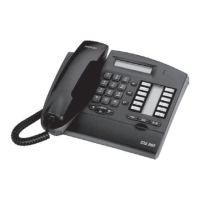File
5
CALL METERING SERVICESAPPLICATIONS
Ed. 04 27/30Réf. 3EH 21000 BSAA
102 (7): Signal Ground (SG)
Reference potential for the junction circuits.
103 (2): Transmitting Data (TD)
The data signals from the DTE are transmitted to the DCE on this circuit.
104 (3): Receiving Data (RD)
The data signals from the DCE are transmitted to the DTE on this circuit.
105 (4): Request To Send (RTS)
This circuit commands the DCE to prepare to transmit on the data channel.
Closed status forces the DCE into transmission mode.
Open status forces the DCE into non transmission mode on the data channel once all the data trans-
ferred on circuit 103 has been transmitted.
When connecting a DTE without a circuit 105, you should loop circuits 105 and 106 on the DCE soc-
ket.
106 (5): Clear To Send (CTS)
This circuit indicates whether the DCE is ready to receive data signals on circuit 104 and to transmit
them on the data channel.
Closed status indicates that the DCE is ready to receive data signals from the DTE on circuit 103.
Open status indicates that the DCE is not ready to receive data signals from the DTE on circuit 103.
In full-duplex mode, this circuit, in association with circuit 105, enables flux control during the data
transfer phase. Closed status means that the remote unit authorizes transmission.
107 (6): Data Set Ready (DSR)
The closure of this circuit indicates that the DCE is ready to operate. This acknowledges the data chan-
nel trunk seizure.
In addition to the trunk seizure, this circuit indicates that the DCE is ready to exchange other signals to
trigger the data exchange (initialize the dialog).
108/1 (20): Connect data set to line (CDSL)
This signal, transmitted by the DTE, forces the DCE to connect to the data channel.
Incoming call: As a general rule, the DTE emits this signal in response to an incoming call defined by
the closure of circuit 125 on the DCE. The DCE then closes circuit 107 as soon as the line is seized,
which triggers the dialog initialization phase. This circuit enables the DTE to remain in control of the
response to incoming calls, postponing or barring trunk seizures during critical operating phases.
Outgoing call: The closed status of this circuit can be used to initialize an outgoing direct call with an
automatic call DCE.

